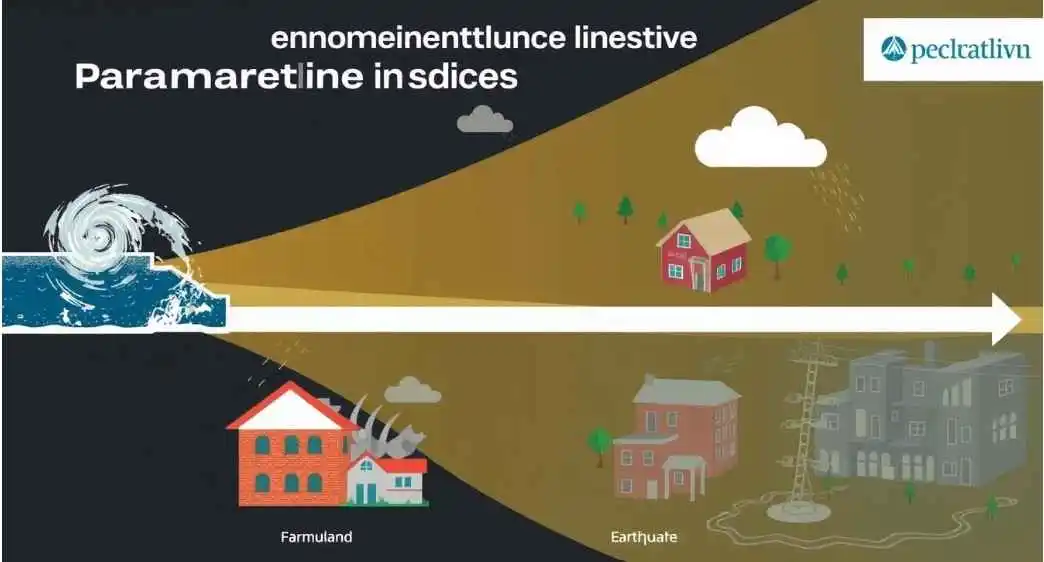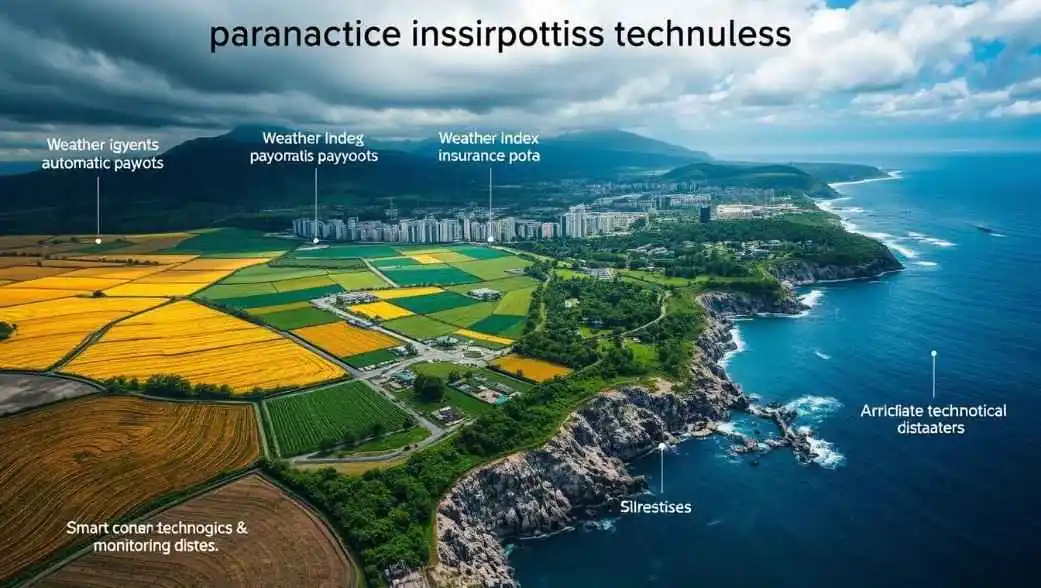Discover how Parametric Insurance offers smart, efficient coverage for specific risks. Learn about automated payouts and customized solutions for your needs.
Imagine insuring your business against natural disasters without the long wait for claims. Parametric insurance is here, offering quick payouts when certain conditions are met. It uses cutting-edge tech like blockchain and IoT for tailored protection.
This smart insurance focuses on the chance of a disaster, not the actual damage. It sets clear triggers, like wind speed or earthquake strength. This gives quick and clear payouts when these conditions are reached.
Key Takeaways
- Parametric insurance offers automated payouts based on predefined triggers, eliminating lengthy claims processes
- Leverages advanced technologies like blockchain and IoT to deliver customized coverage solutions
- Focuses on the probability of a loss-causing event rather than the actual loss incurred
- Provides transparent and fast payouts when predefined thresholds are met
- Beneficial for covering hard-to-insure assets or financial exposures
What is Parametric Insurance?
Since risks are becoming more prevalent in our modern world, a more practical solution is the use of parametric insurance for managing losses. It is not the same the way one understands loss in insurance. Instead of determining the worth of what was lost, payment is triggered for the occurrence of an event for instance a certain wind speed or a rainfall.
This method has many benefits. This is particularly effective where the risks are high and for certain categories of damage. It’s on the rise, especially in Third World countries and with respect to particular risks.
Definition and Key Concepts
Parametric insurance addresses large, infrequent and high-intensity losses. These include natural catastrophes and weather-related losses in agriculture or other business sectors. This form of insurance is usually based on a specified occurrence, unlike traditional insurance which compensates for the loss incurred.
This enhances efficiency in the disbursement of funds as money is obtained in the shortest time possible. Since it would be easier to verify the occurrence of the event than to determine the total loss sustained.
Advantages of Traditional Insurance
Parametric insurance has some big advantages. The money is disbursed rapidly as the event is uncomplicated to affirm. There is also the possibility of lower costs for setting up and processing claims since it is less complicated.
But, it may not provide coverage for risks on the parameter. It is organized within fixed and predefined parameters.
Even with its limitations, it is rapidly becoming more well-known. It is being thought about for utilization even in the United States for flood cover. Understandably, people and businesses appreciate it as it is rather simple and effective.
“Parametric insurance is particularly suited for hard-to-model, low-frequency, high-intensity losses like catastrophic perils and weather-related risks in agriculture or other economic activities.”
| Parametric Insurance | Traditional Insurance |
| Payout based on predefined trigger events Faster payout process Reduced transaction costs Suitable for hard-to-model risks May not cover full basis risk | Payout based on actual loss Longer claims process Higher transaction costs Suitable for a wider range of risks Covers full basis risk |
The last point is that, as with any other emerging concept, it is new to the majority of its potential users and not well understood by all. For some people, the age-old methods of pursuing insurance are difficult to let go of. The same goes with modern finance as customers may see it as containing a huge risk. Most people cannot stay away from it, even though fraud concerns persist even in this system of insurance where data is sourced from third parties.
As per their findings, markets with parametric products are more expensive to penetrate or underwrite. This raises pricing on the insurance plans offered to the consumers. Even people who want to get based more on facts still get back to theoretical-based systems and this even based on third-party data is a dark era waiting to happen.
Parametric Review of Insurance Policies
Parametric insurance is related to natural catastrophes and policies issued relate mainly to such occurrences. Such events are, however, evaluated according to indices, which articulate their degrees of intensity. In such a situation, once it hits a specified threshold, the policy would simply pay out without the need for any claims procedures.
Trigger Events and Indices
The need for parametric insurance arises in respect of pre-agreed events that would mostly result in a loss. Such a policy will have no payment till it is utilized in respect of any occurrences that exceed the specified amount. For example, it would not exceed outlay insurance for an earthquake of seven magnitude to the value of $10 million or an extra rain to $50,000.
This type of insurance is intended to address the deficiencies that exist in the traditional form of insurance coverage. It helps in minimizing the risk to the insured.
Automation of Claim Processing
A major advantage of parametric insurance is the speed of its claims processing. There is no lengthy time required because the claims are paid on the occurrence of an event as opposed to any loss. Once the event rises to that level, the policy pays out rapidly and aids the insured in getting the return in a short time.
Payments are made in full without the adjuster’s loss assessment or any bargaining in days or even less.
| Trigger Event | Payout Percentage |
| Category 1 Hurricane | 0% |
| Category 2 Hurricane | 25% |
| Category 3 Hurricane | 50% |
| Category 4 Hurricane | 75% |
| Category 5 Hurricane | 100% |
In parametric insurance, though the nature of risks varies, the payouts are well-defined and predetermined. For instance, the payout for hurricane insurance for Category 1 is 0% while that for Category 5 is 100%.
Parametric insurance is a stand-alone addition to the existing form of insurance cover that eliminates gaps and pays out more promptly and reliably than the latter. It also allows the insured to determine how the various items (relative to the money) are used.
Developments in Parametric Insurance Technologies
Emerging trends are also changing parametric insurance for the better. The focus in the development of these technologies is specifically on blockchain and smart contracts.
Blockchain and Smart Contracts
Blocklists and Smart Agreements The use of blockchain technology enhances parametric insurance with the use of grade contracts. These contracts eliminate the normal method of paying out claims and replace them with clear fast and instant payments instead. Some of them are programmed to automatically trigger the payment process once conditions are made to gas inflation therefore eliminating both delays and arguments.
There are a few things that can be done on the SDK Board but annul covers all parameters that avoid enforcing laws for optimal coverage. Unlike traditional insurance, this insurance compensates upon a certain predefined event which is more highlighted in parametric insurance.
Satellite and aerial data enhance the parametric cover availability beyond primary tropical cyclone risk. The same stands for the lease of the insurance coverage based on the internet network Analytics or artificial intelligence.
The scope of parametric insurance is large and still expanding at a quick pace. By the year 2031, the market is going to attain a value of 29.3 billion US dollars indicating its relevance in the area of risk management.
Applications of parametric insurance
Parametric insurance is being applied in various sectors as a means of risk financing. It’s good for indemnifying losses incurred from such natural calamities as hurricanes and floods. It pays the affected faster so that businesses and the community can recover faster.
Parametric insurance is also effective for farmers. It assists farmers with losses caused by certain weather conditions. In this way, even the smallholder farmers still receive a form of insurance cover.
It finds applications in business interruptions and travel delays also. It encompasses a set of processes where the parametric insurance is simple and does not call for quickening. Sufficient coverage for each industry is fulfilled.
Studies have indicated that parametric insurance has performed 3.5 times better than conventional forms of support during assistance in times of disaster. It enables the very fast delivery of disaster relief and money. Recently, the parametric cover appears to have developed with products such as SwissRe typhoon insurance and AXA Climate weather risk insurance.

However, parametric insurance has its challenges and Issues. It faces issues like basis risk and data needs. Overcoming these will help it reach more areas and industries.
Metric: An Excellent Parametric Considered Solution
Metric is the best parametric insurance offered by Reask. It alters the attitude of the corporations toward risks. Metric measures wind velocities with a lattice of more than 200 million anemometers. This means no storm is bypassed.
Such accuracy enables Metryc to quote competitive rates. It is efficient and less expensive than pre-existing old enclosure policies.
Precise measurements of wind densities
Regarding advanced science and artificial intelligence, Metryc is up to the task. It accurately simulates tropical cyclones. It also gets the pricing of insurance right, for you.
This, therefore, translates to lower premiums for you. You get proper protection and do not get to pay too much for it.
Adequate pricing of risks
Pricing is one of the biggest highlights in parametric insurance that Metryc delivers. Simply providing old policies behind the box does not equate to insuring against environmental hazards. You will have the prices issued by Metryc that are charged according to the risk and probability of wind at your point.
This means that those young people who are remodelling their houses will be able to pay for the unitary rate that comprises a whole range of other units that are no longer necessary. This is good, and it does not harm Insurers as well.
The revolution in the insurance market is been brought by Metric. It provides companies with smarter ways to manage risks. What Metryc has done in tech and data, it is a front runner in the parametric insurance market.
Parametric Insurance Challenges and Solutions

Although forming a large share of the insurance market, parametric insurance still has a multitude of challenges to conquer. One of them is related to basic risk management. Basis risk arises where a risk is covered or insurable but losses or the payout leaves a residual that is uncovered. To do it more accurately, companies like Metric employ various sensors to determine, for instance, the wind speed on site.
Basis Risk Minimization
Basis risk is a well-known issue for holders of parametric insurance solutions. The reason is the payment made under the insurance is made on what is called the index and not on the actual loss suffered. From the insurer’s standpoint, this requires that data for making the payments is accurate and geographically relevant. To do this, Metryc fitted policyholders’ sites with a network of anemometers to measure wind direction and wind speed under which the equipment will work. This is a part of bringing the index closer to the respondents.
Compliance with Regulatory Requirements
With the expansion of parametric insurance, it has also become apparent that its growing pains are running deftly within the rules. Providing insurance is a grey area, but certain restrictions and rules have to be respected and these differ from one jurisdiction to another. They have to take into account issues such as transparency, the mechanics of how claims are energetic and up-and-coming technologies like blockchain. Regulatory barriers are critical issues all over the world, no matter how advanced it is – particularly thus, a need to mitigate them gets greater for parametric insurance.
However, there are some drawbacks, but the key benefits of parametric insurance are hard to neglect. It ensures faster and more transparent payouts in case the risk insured occurs and hence can actually be more effective at covering many risks. In addition, as the field continues to mature, it will be important to address other forms of basis risk and regulatory risk as well.
“Parametric insurance holds promise in providing efficient coverage for certain risks and is expected to see further innovation and adoption in the insurance industry.”
Conclusion
The parametric insurance is a leap forward. It provides rather clever, effective and technology-driven means of blanket coverage. This approach employs modern technology to provide speedy payouts and adequate pricing of insurance risks. It assists individuals and businesses with funds that enable them to rise quickly from certain risks.
The prospects of parametric insurance are endearing. It could cover more people and improve upon the experience they had there. It is amazing for companies which are seeking for improved and seekrie shed. It also blends in with normal insurance improving the efficacy of risk management.
Thus, in conclusion, parametric insurance is also a matter for the most comfortable and bright prospects. It uses the latest databases, automation and individually tailored insurance. Thus this remains an effective measure against various adversities from natural hazards to supply chain disruptions. As it continues to be utilized, it will become important in protecting businesses during turbulent environments.
FAQ-Parametric insurance
What is Parametric Insurance?
Insurance payout seems to be complicated but happens when a certain event occurs rather than the occurring loss. The pre-test usually guarantees the maximum that can be made. It is rather assessed on the parameters that are generally too high, such as the wind speed and the magnitude of earthquakes.
What are the advantages of Parametric Insurance over Traditional Insurance?
One of the main benefits of parametric insurance is that it is quick and easy. It provides fast payments and low risk too. It is also very specific as to what is insured and what is not where conventional insurance falls short.
How does Parametric Insurance work?
Parametric insurance works most often in the case of certain events natural catastrophes for instance. It provides measures by way of indexes to the parameter of expressions of such events. On reaching the specified score index for the particular event, the insurance cover takes effect and compensation is affected.
How are Emerging Technologies Shaping Parametric Insurance?
Parametric insurance is evolving with new technologies such as the arrangement of clauses that automatically release a chain of payments. One such can be the annexation of block chain. It makes the payments quick and no justice can stand in between. Payouts can be started with smart contracts without the engagement of people which is a time saver.
What are the applications of Parametric Insurance?
Parametric insurance finds applications in a lot of places. It protects against typhoons, loss of crops, business halts, delays in travel. It enables individuals and businesses to respond quickly to particular risks.











